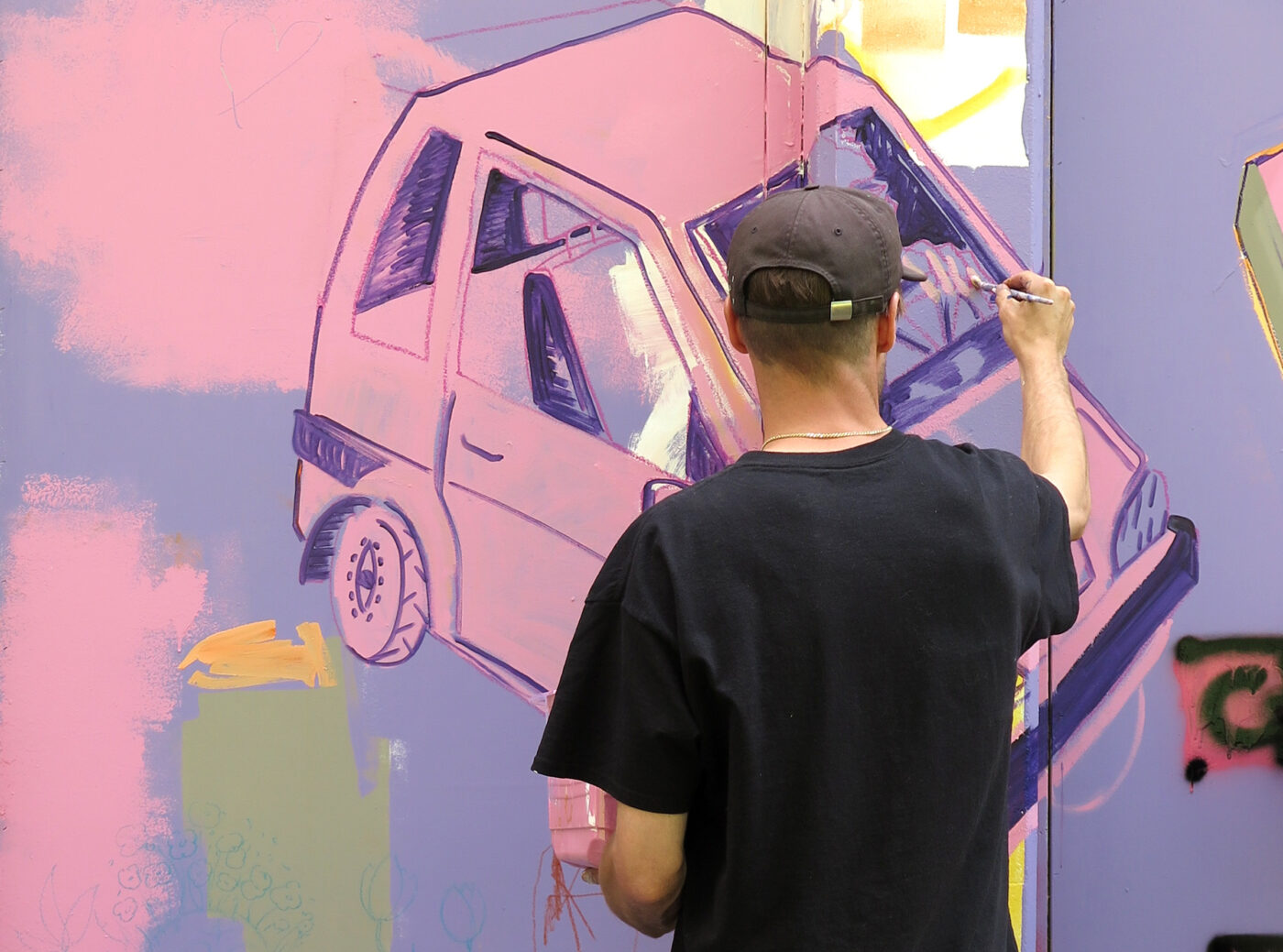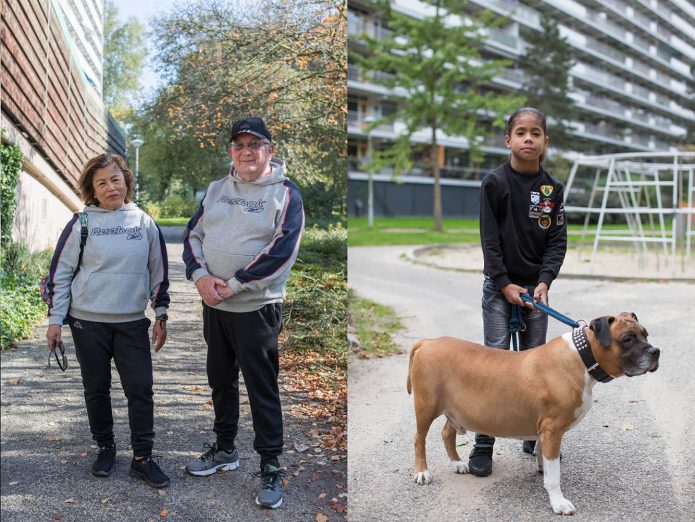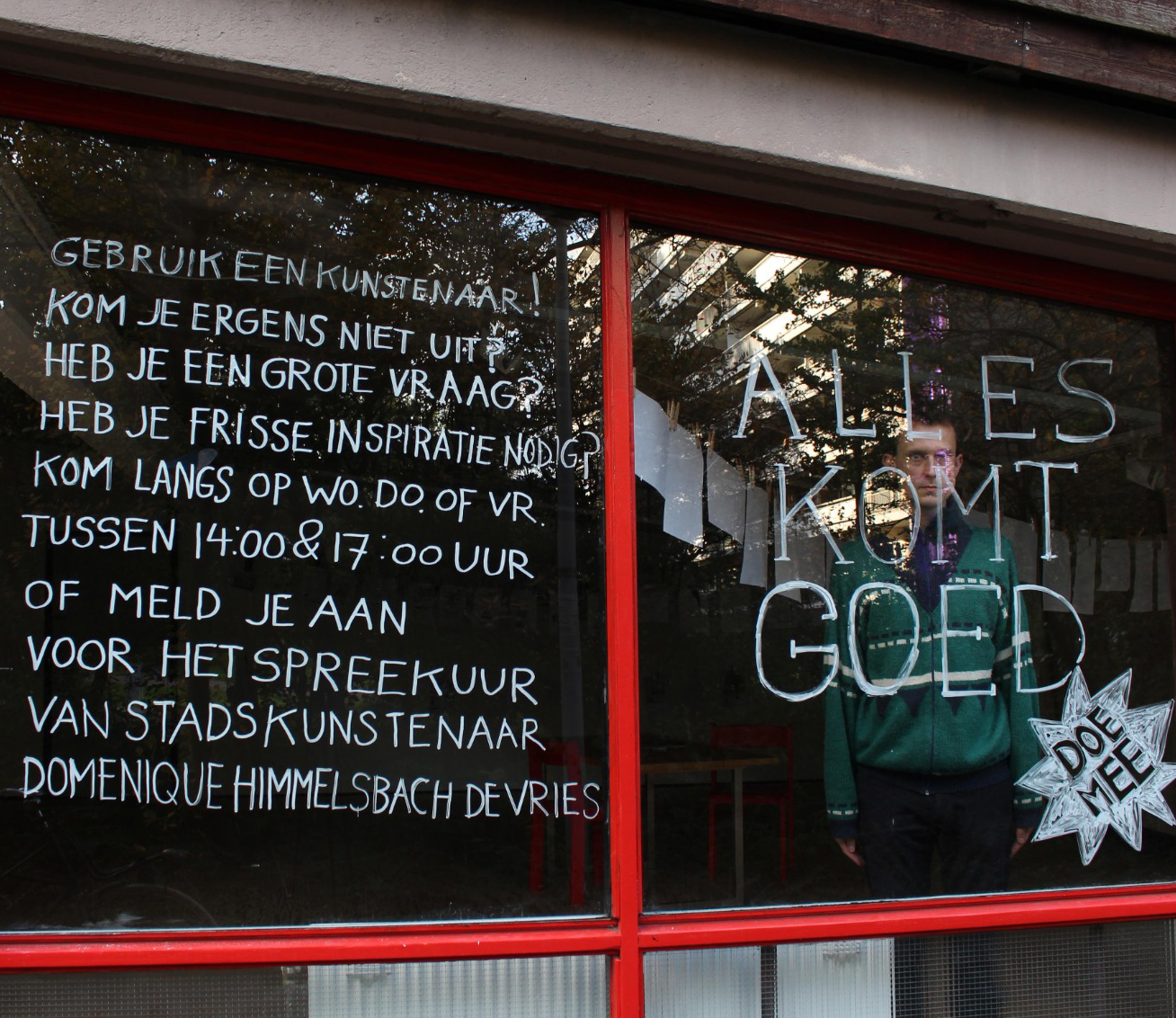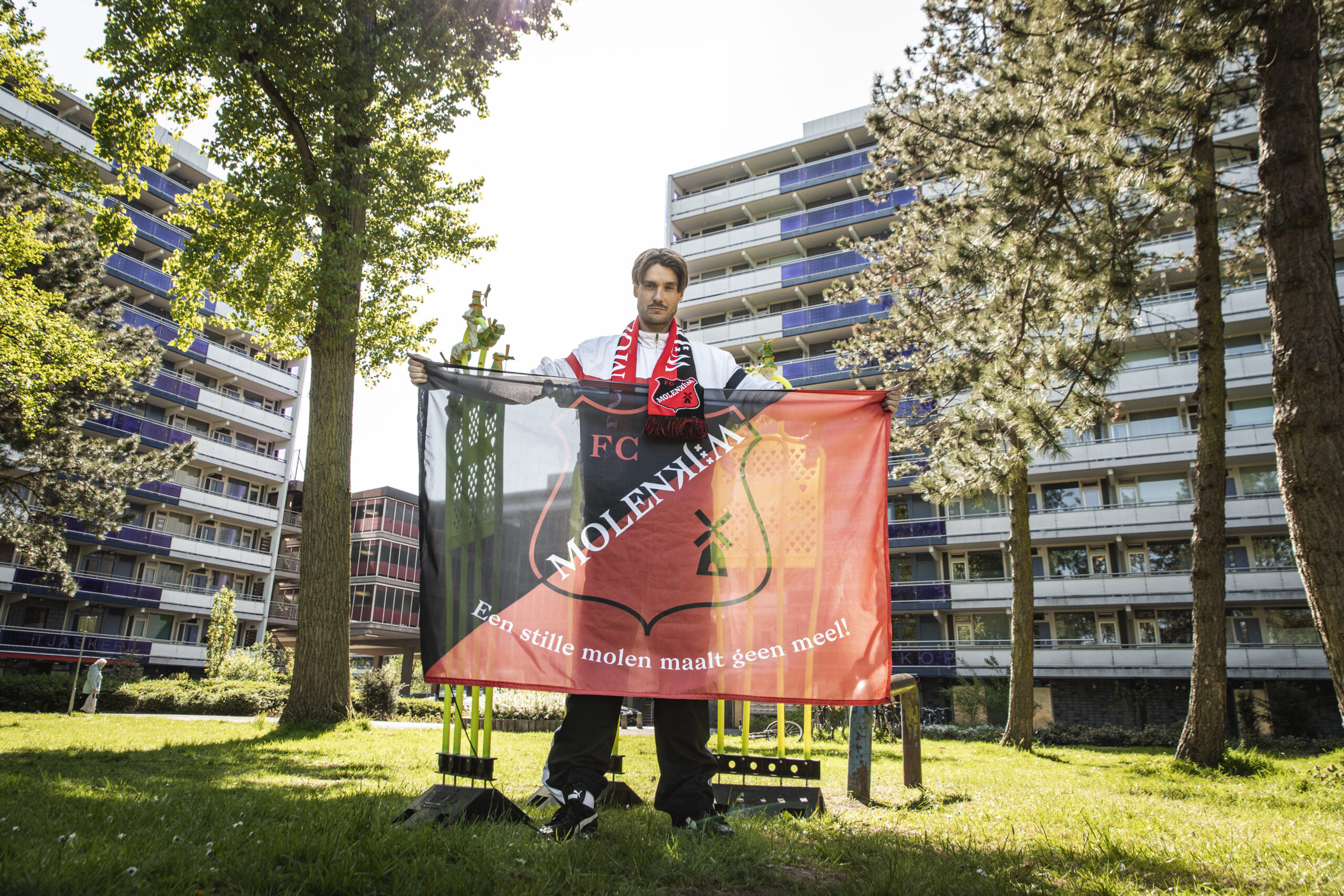
Residencies
At Werkplaats Molenwijk, Framer Framed offers space for artist residencies, where artists temporarily live in the neighbourhood and create new work in dialogue with the community.
50 jaar Molenwijk
Documentary photographer, Florian Braakman was the first resident to move into the Werkplaats Molenwijk between October and November 2018.
During his residency, the artist worked together with local residents on an exhibition to celebrate 50 years of Molenwijk. He searched for visual material about the neighbourhood by local residents, and made new photographic work together with them. For this purpose, he had set up a special 'image consultation hour'.
Molenwijk residents with photos or other ideas could drop by during this consultation hour. Material from the personal archives of local residents and the new work that Florian Braakman created during his residency were part of the exhibition 50 years Molenwijk. As part of the project, a 2,500-copy local paper was distributed door-to-door. Buy the digital version of the paper on our webshop!

Portraits of Molenwijk residents, by Florian Braakman (2018)
Van Amulet tot Artefact
In the summer of 2019 design anthropologist Tina Lenz and filmmaker Magda Augusteijn began their artistic research into the rituals and routines of the Molenwijk residents. Three days a week the door to the Werkplaats was open, and anyone who curiously poked their head around the corner was welcomed with a cup of coffee, red ribbon, felt-tip pen and the invitation to write down their wish for a wish tree in the neighbourhood.
In September 2019, the exhibition Van Amulet tot Artefact was opened with collaborations from 25 local residents. In a series of photos and a short film, the exhibition showed a collection of personal stories and meaningful objects, such as your grandmother's necklace, a cap from your baseball club or a souvenir from a special moment. Magda Augusteijn made a short documentary about the Molenwijk, especially for the exhibition. Read more in depth about the project here. The exhibition was also transformed into a publication available online or at the Framer Framed bookshop.

Tina Lenz works on the exhibition From Amulet to Artefact (Amsterdam, 2019)
Molenwijk Originals
TuncTop was the artist resident of Workshop Molenwijk from October 2019 onwards. While there, the first thing he did was open the cinema 'Our Cinema' to meet his new neighbours. TuncTop got to know many people during his stay in the Molenwijk: from vendors, children, young people and old ladies, to Afghan, Syrian and Ugandan newcomers. Each of these characters told him special and interesting stories. TuncTop had only one question for his new neighbours: what will happen in 2050?
With the answers, he made the scifi series Molenwijk Originals (2019) starring residents of the Molenwijk. After spending almost two months in Molenwijk, screening films with the smell of fresh popcorn, having conversations, drinking coffee together and of course filming a lot, he was ready to share his six-part series he made together with Molenwijkers with the public. The result was shown on 6 December 2019. What is fiction, what is reality? It is the result of the residency TuncTop in the neighbourhood.
Ecognosis
During their residency BetweenTwoHands - an artistic duo consisting of Erin Tjin A Ton and Gosia Kaczmarek - created a series of stop-motion animations. This residency was hit by the first lockdown and was therefore converted into a 'home residence'. The videos were visible through the windows of Werkplaats Molenwijk and thus shared with the neighbourhood. The BetweenTwoHands theatre installation, Ecognosis, was inspired by the book The World Without Us, written by Alan Weisman. In his book, Weisman describes how nature, in different parts of the world, would take over if humans would disappear on earth.
BetweenTwoHands depicted the idea of such a world and created animations in collaboration with local youth and artist Martine Rademakers in which insects and plants cover everyday objects in the neighbourhood.
The work of BetweenTwoHands was also presented at the digital exhibition Corona in the City, where Framed Framed set up a virtual exhibition space with Drawing Stories. This digital exhibition shows the impact of the corona virus on the city of Amsterdam and its inhabitants. Several organisations contributed to this exhibition and the building of a collection during a drawing period for the city, including Framed Framed.
The development of Ecognosis was made possible by Stichting Stokroos, Creative Industries Fund NL, Gemeente Amsterdam, Framer Framed and Performance Technology LAB.
Himmelbach de Vries - Ideeënbibliotheek
For two months, social artist Domenique Himmelsbach de Vries worked on a library of ideas consisting of 120 sketches for social interventions, which he deployed as a conversational piece. On the basis of these plans, residents of the neighbourhood discussed their own issues during weekly consultation hours organised by him in Werkplaats Molenwijk, in order to receive artistic reflection and develop new ideas. The aim was - especially in these times when pessimism lurks - to give a practical, playful twist to the visitors' situation. The consultation hour was also an exploration of a possible evolution of his artistry into urban artistry, an artist in the service of the city, working on the issues of residents and administrators.
At the end of his residency, Himmelsbach made the elaborated Library of Ideas available to the residents of Molenwijk in a way that nobody could do without. Some 120 idea sketches were hung on lampposts throughout the district from Friday, 4 December 2020, making them freely accessible. With this, Himmelsbach invited the local residents to take an inspirational walk through Molenwijk in these dark days and to apply his unconventional way of thinking to their own issues.


GEEF - Bert Scholten
Multidisciplinary artist Bert Scholten took inspiration from the wealth of local customs and traditions in the Netherlands. He uses traces of the past to tell new stories. For his residency at Werkplaats Molenwijk, the artist brought a whole stack of wooden bread moulds or ‘koekplanken’ with him. Over the past few months, he and the residents have been looking into the hidden meanings that these pieces of heritage carry with them.
During this period, he hosted a workshop entitled Hidden Stories, where children were free to walk-in and learn about the history of the koekplank and imagine their own traditions and interpretations in drawings. Bert then used these drawings to create new koekplanken that were distributed in the neighbourhood. He also gave concerts on the balconies of Molenwijk residents, singing songs based on the fantasy stories of the koekplanken. In the space between public and private, Bert formed a special relationship with the hospitable and open members of the neighbourhood. The results of his residency came together in the exhibition GEEF (2021-2022).

Anan Striker - Denken met de Hand
The following resident Anan Striker is a painter, sculptor, typographer, poet and tape-jockey. As a versatile artist, he isn’t preoccupied with a particular subject. Rather, through intuition, he renders everyday events, occurrences and objects into art. His residency in the spring of 2022 led to many unexpected and rewarding interventions, such as hand-crafted new swings for the neighbourhood.
In order to make connections with and between the residents, Anan created the football team F.C. Molenwijk, complete with a logo, flag, scarf and of course a match for Molenwijk children to get involved. He ended his residency by painting a colourful mural in the Molenwijk, in co-operation with housing corporation De Alliantie and with images from conversations with the local children. Through his playful exhibition, Denken met de hand, Anan brought Molenwijk life from the high-flats into the shared public space.

Een ontluikende bloem maakt een tuin
Indonesian artist Ratu R. Saraswati, also known as Saras, undertook her residency in the Werkplaats Molenwijk in the autumn and winter of 2022. Saras took her practice of storytelling, performance, and photography to engage with the concept of the garden in the Molenwijk. She was inspired by the history and the daily encounters with the resident gardeners of the Molenwijk like Annie, a neighbourhood resident for 32 years (originally from Friesland) and founder of the Wipmolentuin community garden 30 years ago; Hella, another resident working with Annie in the garden; Toon, a neighbour who frequents the Molenwijkkamer; and Muhammad, a municipal gardener tending to the green spaces around the neighbourhood outside the garden.
In the resulting exhibition, A rising flower makes a garden, Saras presented a poignant and touching record of her residency through photography, calligraphy and performances at the opening and finissage.

Jakup Ferri - We We
Over the past years artist Jakup Ferri has cultivated a way of utilising fabrics and other found objects for his textile works made in collaboration with women from different cities and villages in Albania, Kosovo, Burkina Faso and Suriname. These collective works demonstrate embroidery work as techniques of social coherence and community building. They also communicate the labour and intricate knowledge involved in this bodily practice.
During his residency at Werkplaats Molenwijk - between Spring and Autumn of 2023 - Jakup Ferri worked with the Molenwijk door elkaar group, a community project organised by Framer Framed and Stichting BMP. The group, composed mainly of women from the neighbourhood, gathers weekly at the Werkplaats. Together with these ladies, Jakup developed a series of new drawings consisting of diverse characters in dynamic and engaging scenarios. These sketches are then applied on fabrics through the hands of the Molenwijk ladies, and further passed on to local artisans in Kosovo for finalisation. With this route, We We demonstrates the trajectory of both the artists' own journey as well as the collaborative effort involved in the artistic process. The colourful works compose a captivating visual landscape depicting unique stories about Molenwijk and beyond, inviting visitors to encounter, experience and engage in.

Golrokh Nafisi - Walvistraan
Storytelling has been the core of artist Golrokh Nafisi’s artistic practice. Through her visual and textual narration, we fall into a fictional world derived from private memories, daily realities, as well as historical incidents often forgotten or overlooked. These individual and collective stories create spaces where feelings are offered a voice, where our world can be reimagined with many possibilities.
She began her residency at the end of August 2023, starting with simple yet touching sketches of the daily activities of the Molenwijk inhabitants. Soon her imagination went wild and after she studied the multi-layered human and non-human histories co-inhabiting the Molenwijk neighbourhood, Golrokh created fantastical characters - such as moles and whales.
On the occasion on the Werkplaats Molenwijk 5-Year Anniversary, Golrokh presented a musical performance that guided visitors through the neighbourhood and invited them to completely reimagine their surroundings.
Her presentation Walvistraan (much like her residency as a whole) is considered a journey that will eventually sprout into a publication, where diverse spirits, species and beings of Molenwijk from past, present and future come together, — with all its joy and fear, loneliness and togetherness.
